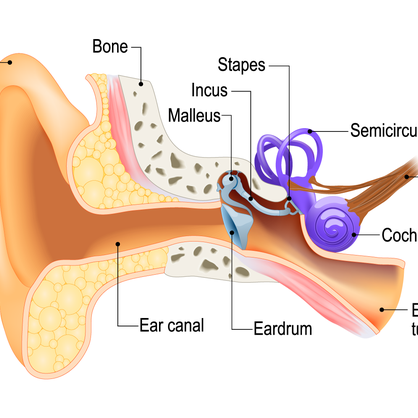Correct Otosclerosis with Stapedectomy

The ear bones transfer sound from the ear canal to the cochlea.
The three bones in our ears, the stapes, incus, and malleus, play an essential role in hearing.
Otosclerosis is a condition that can impair your hearing due to a buildup of bone tissue around the stirrup bone, or stapes, which prevents it from moving properly. A stapedectomy is a surgical procedure performed to remove and replace all or part of the stapes with the goal of restoring normal hearing.
The doctors at Chesapeake Ear Nose & Throat in Baltimore, MD, have undergone advanced otology training to perform safe, effective treatment for a wide range of conditions, including otosclerosis. Our team is dedicated to providing you with the highest level of care to help you improve your quality of life.
Do You Need Stapedectomy?
If you suffer from severe otosclerosis and have not been able to improve your hearing with conservative treatment methods such as a hearing aid, you may need surgery. Otosclerosis is a type of conductive hearing loss. In a normally functioning ear, the ear bones vibrate to conduct sound to your cochlea. With otosclerosis, however, bone builds up around the stapes, preventing it from moving properly.
A stapedectomy can be performed to remove the structural issue that is impairing your hearing. We will work with your general physician to ensure that you receive the best treatment solution for your needs.
The Surgical Process
Typically, this surgery will take about an hour. To begin, an incision will be made in the ear canal near the eardrum to access the stapes, incus, and malleus. The doctor will then remove the entirety or a portion of the stapes that is restricting movement. A prosthetic is then used to replace the stapes and restore proper function. A small amount of tissue will then be taken from the back of the ear and placed over to seal the treatment area. Once complete, your doctor will then check the functionality of the stapes to ensure the other two bones are interacting properly.
The doctors at Chesapeake Ear Nose & Throat in Baltimore, MD, have undergone advanced otology training to perform safe, effective treatment for a wide range of conditions.
Recovering from Your Stapedectomy
Stapedectomy is an outpatient surgery, so you will be released shortly after your procedure. To help manage any discomfort, pain medication will be prescribed and should be used as recommended.
The inner ear will need to remain dry. Wait at least two days to wash your hair and use a cotton ball with vaseline on it to plug your ear when you start showering. Additionally, you should not participate in water-related activities such as swimming or diving. It is essential that you also avoid strenuous activities such as lifting heavy objects. You should also avoid flying for about two weeks after your procedure.
Post-Op Appointments
About one week after surgery, you will return to our office to have your sutures and ear packing removed. Six weeks post-op you will undergo an audiogram to test your hearing. Depending on your progress, you may need to continue checkups for about another six months.
Improve Your Quality of Life
There is no need to suffer through a hearing impairment if you prefer not to. To find out if stapedectomy can help you overcome hearing loss, contact us online, call us at our Owings Mills office at (410) 356-2626 or reach out to our other convenient locations.
“I received excellent care at Chesapeake ENT. Their prompt response and cheerful attitudes made for a wonderful experience. All of the audiologists were very helpful. Especially Dr. Laura Toll, her knowledge of hearing aids and the new technology offered made for an easy decision."
★★★★★
- Tanya
"Was very knowledgeable and helpful."
★★★★★
- Saafir
"Very courteous and on time."
★★★★☆
- Pauline




